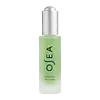What's inside
What's inside
 Key Ingredients
Key Ingredients

 Benefits
Benefits

 Concerns
Concerns

No concerns
 Ingredients Side-by-side
Ingredients Side-by-side

Aloe Barbadensis Leaf Juice
Skin ConditioningHelianthus Annuus Seed Oil
EmollientGlyceryl Stearate Citrate
EmollientCetearyl Alcohol
EmollientGlyceryl Caprylate
EmollientGlycerin
HumectantPopulus Tremuloides Bark Extract
AntiseborrhoeicCaprylhydroxamic Acid
Limnanthes Alba Seed Oil
Skin ConditioningGalactoarabinan
Cetyl Palmitate
EmollientOctyldodecanol
EmollientRibes Nigrum Seed Oil
EmollientHelianthus Annuus Seed Oil Unsaponifiables
EmollientCardiospermum Halicacabum Flower/Leaf/Vine Extract
Skin ConditioningTocopherol
AntioxidantRosmarinus Officinalis Leaf Extract
AntimicrobialHippophae Rhamnoides Fruit Extract
Skin ConditioningSantalum Spicata Wood Oil
PerfumingRosa Damascena Flower Oil
MaskingCitrus Aurantium Amara Flower Oil
MaskingCymbopogon Citratus Leaf Oil
MaskingCalendula Officinalis Flower Extract
MaskingSodium Phytate
Sodium Anisate
AntimicrobialSclerotium Gum
Emulsion StabilisingXanthan Gum
EmulsifyingCitric Acid
BufferingAloe Barbadensis Leaf Juice, Helianthus Annuus Seed Oil, Glyceryl Stearate Citrate, Cetearyl Alcohol, Glyceryl Caprylate, Glycerin, Populus Tremuloides Bark Extract, Caprylhydroxamic Acid, Limnanthes Alba Seed Oil, Galactoarabinan, Cetyl Palmitate, Octyldodecanol, Ribes Nigrum Seed Oil, Helianthus Annuus Seed Oil Unsaponifiables, Cardiospermum Halicacabum Flower/Leaf/Vine Extract, Tocopherol, Rosmarinus Officinalis Leaf Extract, Hippophae Rhamnoides Fruit Extract, Santalum Spicata Wood Oil, Rosa Damascena Flower Oil, Citrus Aurantium Amara Flower Oil, Cymbopogon Citratus Leaf Oil, Calendula Officinalis Flower Extract, Sodium Phytate, Sodium Anisate, Sclerotium Gum, Xanthan Gum, Citric Acid
Water
Skin ConditioningCodium Fragile Extract
Skin ConditioningBetaine
HumectantSodium Hyaluronate
HumectantTremella Fuciformis Sporocarp Extract
AntioxidantBacillus Ferment
Skin ConditioningHydrolyzed Hyaluronic Acid
HumectantGlycerin
HumectantSodium Benzoate
MaskingPotassium Sorbate
PreservativeCitric Acid
BufferingLonicera Japonica Flower Extract
Skin ConditioningLonicera Caprifolium Flower Extract
PerfumingCopper Chlorophyll
Cosmetic Colorant
 Reviews
Reviews

Ingredients Explained
These ingredients are found in both products.
Ingredients higher up in an ingredient list are typically present in a larger amount.
Citric Acid is an alpha hydroxy acid (AHA) naturally found in citrus fruits like oranges, lemons, and limes.
Like other AHAs, citric acid can exfoliate skin by breaking down the bonds that hold dead skin cells together. This helps reveal smoother and brighter skin underneath.
However, this exfoliating effect only happens at high concentrations (20%) which can be hard to find in cosmetic products.
Due to this, citric acid is usually included in small amounts as a pH adjuster. This helps keep products slightly more acidic and compatible with skin's natural pH.
In skincare formulas, citric acid can:
While it can provide some skin benefits, research shows lactic acid and glycolic acid are generally more effective and less irritating exfoliants.
Most citric acid used in skincare today is made by fermenting sugars (usually from molasses). This synthetic version is identical to the natural citrus form but easier to stabilize and use in formulations.
Read more about some other popular AHA's here:
Learn more about Citric AcidGlycerin is already naturally found in your skin. It helps moisturize and protect your skin.
A study from 2016 found glycerin to be more effective as a humectant than AHAs and hyaluronic acid.
As a humectant, it helps the skin stay hydrated by pulling moisture to your skin. The low molecular weight of glycerin allows it to pull moisture into the deeper layers of your skin.
Hydrated skin improves your skin barrier; Your skin barrier helps protect against irritants and bacteria.
Glycerin has also been found to have antimicrobial and antiviral properties. Due to these properties, glycerin is often used in wound and burn treatments.
In cosmetics, glycerin is usually derived from plants such as soybean or palm. However, it can also be sourced from animals, such as tallow or animal fat.
This ingredient is organic, colorless, odorless, and non-toxic.
Glycerin is the name for this ingredient in American English. British English uses Glycerol/Glycerine.
Learn more about Glycerin